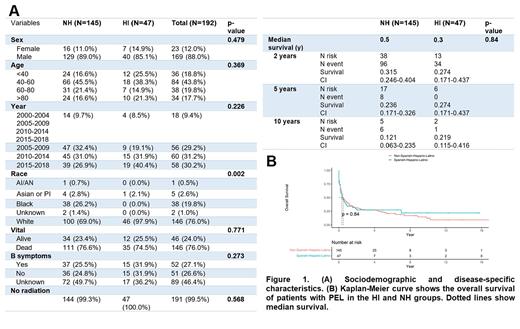Abstract
BACKGROUND Primary Effusion Lymphoma (PEL) is a rare aggressive B-cell malignancy that occurs most often in immunocompromised patients and accounts for approximately 4% of HIV-related Non-Hodgkin's Lymphomas (Cancers, PMID: 35158997). It is characterized by neoplastic effusions in the absence of a detectable mass. Pathogenesis is related to HHV-8 infection. There is no standard of care treatment, all PEL cases are considered stage IV by definition, and the prognosis remains poor with overall survival (OS) of around 30% at 1 year (Blood, PMID: 30154110). This is the first population-based national retrospective study of PEL comparing survival and outcomes in the Hispanic (HI) and non-Hispanic (NH) populations. Understanding the impact of ethnic disparities has fundamental implications for the creation of effective approaches to reduce inequities.
METHODS: Data from the Surveillance, Epidemiology, and End Results (SEER) 18 database on PEL were analyzed between 2000 and 2018. SEER 18 contains the most comprehensive population-based cancer information in the U.S., covering approximately 27% of the total US population, and up to 36% of HI alone. Racial groups analyzed included NH whites, HI whites, blacks, and Asians/PIs (Pacific Islanders). Patient characteristics, age-adjusted incidence rate, and survival rate were compared across ethnic groups, HI vs NH. Stratification by age and gender at diagnosis was considered. Kaplan-Meier and Cox regression analyses were used to compare OS between HI and NH. Multivariate analysis and propensity score matching were performed with adjustment for age.
RESULTS Between 2000 and 2018, 192 (HI: N=47, NH: N=145) patients were registered with PEL in the SEER 18 database. Of those 24% were HI, and 76% were NH. Male sex predominated for both HI (85%) and NH (89%). As compared to NH at diagnosis, HI pts were older, with a median of 52 y.o vs. 51 y.o (p=0.63). The majority of HI (38%) and NH (45%) were diagnosed in the same age bracket of 40-60 years (p=0.369). Most HI and NH were whites (98% vs 69%). The second most predominant group was Asian/PI among HI (2%) and blacks among NH (26%). The majority of HI (40%) were diagnosed between the years 2015-2018, while the majority of NH (32%) were diagnosed between the years 2005-2009 (p=0.226).
The survival probability at 2, 5, and 10 years of HI vs NH were 0.274 (95% CI: 0.171-0.437) vs 0.315 (95% CI: 0.246-0.404), 0.274 (95% CI: 0.246-0.404) vs 0.236 (95% CI: 0.171-0.326), and 0.219 (95% CI: 0.115-0.416) vs 0.121 (95% CI: 0.063-0.235), respectively (Figure 1A). The median survival time was 0.3 years for HI vs 0.5 years for NH; and there was no significant OS difference favoring NH (p=0.84, Figure 1B).
On multivariate analysis, when adjusted for age, those patients who were older than 80 y.o and between 60 to 80 y.o, had worse OS compared to those younger than 60 y.o, with HR 1.8 (95% CI: 1.1 - 2.9 ) and 1.3 (95% CI: 0.8 - 2.1) respectively.
CONCLUSION The highest prevalence of PEL was found in males. Overall, there was no significant difference in median age at diagnosis and survival of HI compared to NH. This may be explained by homogeneity of care between ethnic groups, the aggressive nature of this lymphoma without a standard of care treatment leading to similar mortality, or insufficient sample size. Only older ages at diagnosis (>60y.o) exhibited worse OS. Further studies are needed to determine the implications of ethnic disparities in PEL.
Disclosures
Diaz Duque:Epizyme: Consultancy; Astra Zeneca: Consultancy; Morphosys: Consultancy; ADCT: Consultancy; Incyte: Consultancy.
Author notes
Asterisk with author names denotes non-ASH members.


This feature is available to Subscribers Only
Sign In or Create an Account Close Modal